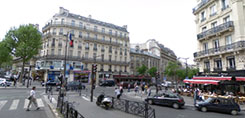Sustainable streets: Can DC match the excellence of Paris?
Janette Sadik-Khan has had a profound impact as Commissioner of New York City’s Department of Transportation. The city that never sleeps has been transforming its streets into a more sustainable mold. Since her arrival, NYC DOT has added buffered bike lanes, express bus lanes, public plazas and much more. While these bold ideas are overdue for a city in which 54% of households do not own cars, the ideas are not new. European cities like Copenhagen and Paris have been shifting towards sustainable streets for some time.
Streetsblog reported how Paris has dramatically reduced car ownership this decade. Mayor Bertrand Delanoë, realizing congestion pricing was considered politically untenable, focused on altering behavior by transforming the streets.
In 2002, (Delanoë) launched Quartiers Verts (“Green Neighborhoods”), an initiative to improve pedestrian space and reduce traffic in residential areas. The administration anticipated especially strong opposition to the parking policies in the plan — higher rates, a reduction in the amount of on-street parking, and the elimination of free parking altogether. To counteract the expected outcry, the city tied those reforms to the introduction of residential parking permits, which are now available for a nominal yearly fee.
Delanoë‘s next major initiative — Espaces Civilisés (“Civilized Spaces”) — took aim at Paris’s most car-friendly boulevards. The first such project, on Boulevard de Magenta, trimmed a six-lane road down to two traffic lanes and two bus lanes, with the remainder going to sidewalks and street trees. This substantial redistribution of space did not happen overnight. Launched in 2002, Espaces Civilisés yielded its first finished boulevard in 2005. About half a dozen such transformations have been completed so far, with plans for another on the way.
The brief slideshow above, made from Google Street View screen captures, highlights Paris’ wide plaza-esque medians, bus and cycle lanes, reduced curb parking, extensive cross walk striping, mixed pavers, and willingness to program public space rather than simply plant ornamental trees, grass and the occasional statue. I did not cherry pick streets in the Parisian museum or government districts for the slideshow. Nearly all intersections of Boulevards and Avenues in the city center are ripe with grandeur. In fact, Paris boldly devoted the median of Boulevard Pereire to 5 tennis courts end to end!
DC presently falls well short of Paris’ comprehensive screetscapes. Perhaps it is not fair to compare our city, only recently on the rebound from the 1968 riots, to an iconic European city often described as a giant open air museum. However, when I walk downtown and see ornamental trees, modestly landscaped narrow medians or major intersections without public space, I wonder if we’ve set the bar too low. Will DC just settle for matching the low standard of American cities’ streets, or will it take the real risks to become world class?

